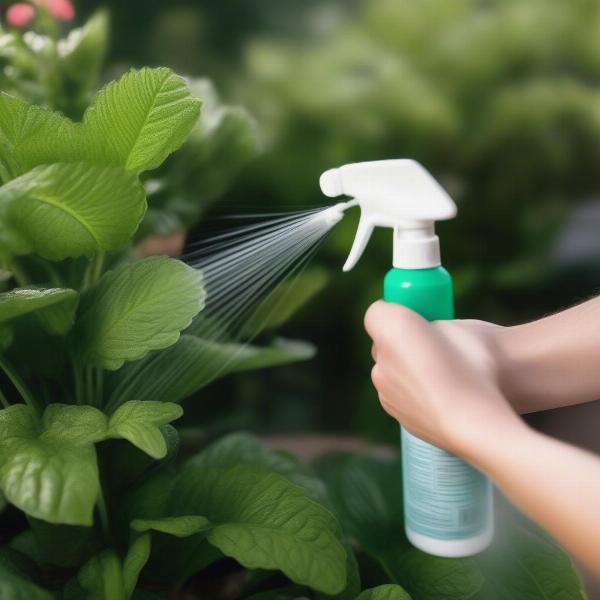Repellent for cats and dogs can be a valuable tool for pet owners looking to protect their gardens, furniture, and other areas from unwanted pet behaviors. Whether you’re dealing with your own furry friends or neighborhood animals, choosing the right repellent can be crucial for maintaining a harmonious environment. This article will explore the various types of repellents available, discuss their effectiveness, and guide you through choosing the best option for your specific needs.
Types of Cat and Dog Repellents
There are a variety of repellents on the market, each working through different mechanisms. Understanding these differences will help you make an informed decision.
Scent-Based Repellents
Many repellents utilize scents that cats and dogs find unpleasant, deterring them from the treated area. Common scents include citrus, citronella, and peppermint. These are often available as sprays, granules, or diffuser sticks. Some are made with natural essential oils, while others contain synthetic fragrances.
Ultrasonic Repellents
These devices emit high-frequency sounds that are inaudible to humans but can be irritating to cats and dogs. When an animal approaches the protected area, the device activates, deterring them with the unpleasant sound.
Water-Based Repellents
Motion-activated sprinklers are a humane and effective way to deter animals. When a cat or dog enters the sensor’s range, a sudden burst of water startles them and discourages them from returning.
 Cat and dog repellent spray being applied to garden plants.
Cat and dog repellent spray being applied to garden plants.
Choosing the Right Repellent for Dogs and Cats
The best repellent for your situation will depend on several factors, including the specific area you’re trying to protect, the severity of the problem, and your personal preferences.
Consider the Location
For indoor use, scent-based repellents or ultrasonic devices can be effective. For outdoor areas, granules, sprays, or motion-activated sprinklers are more suitable.
Think About the Animal’s Temperament
Some animals are more sensitive to certain scents or sounds than others. You may need to experiment with different repellents to find what works best.
Prioritize Safety
Always choose a repellent that is safe for both pets and humans. Read the product label carefully and follow the instructions for use.
Natural Repellent Options
Many pet owners prefer natural repellents to avoid exposing their animals or family to harsh chemicals.
Homemade Repellents
A mixture of citrus peels and water can be a simple and effective homemade repellent. Similarly, a strong vinegar solution can deter animals from certain areas.
Commercially Available Natural Repellents
Several brands offer repellents made with natural ingredients like essential oils. Look for products that are specifically formulated for cats and dogs.
Applying Repellents Effectively
For best results, follow these tips:
- Consistency is Key: Apply the repellent regularly, especially after rain or watering.
- Target Problem Areas: Focus on areas where the animals are most likely to cause damage.
- Reapply as Needed: The frequency of application will depend on the specific product and environmental conditions.
Are Repellents Cruel?
When used correctly, repellents are a humane way to deter unwanted behavior. They provide a negative association with a specific area, encouraging the animal to stay away without causing physical harm.
Conclusion
Choosing the right repellent for cats and dogs involves careful consideration of your specific needs and the animal’s behavior. By understanding the different types of repellents available and following the guidelines for safe and effective application, you can create a more harmonious environment for both pets and people. Remember to always prioritize safety and choose products that are specifically designed for use around animals. Investing in a good quality repellent can save you time, money, and frustration in the long run.
FAQ
- Are ultrasonic repellents safe for dogs with sensitive hearing? Some dogs may find ultrasonic repellents irritating. Observe your dog’s reaction and discontinue use if they show signs of distress.
- How often should I reapply scent-based repellents? Reapply every few days or after rain, following the product instructions.
- Can I use repellents indoors? Yes, some repellents are specifically designed for indoor use. Be sure to choose a product that is safe for indoor environments.
- Will repellents harm my plants? Most repellents are safe for plants when used as directed. Always check the product label for specific instructions.
- What if the repellent doesn’t seem to be working? You may need to try a different type of repellent or adjust your application technique.
- Are there any home remedies for cat and dog repellents? Yes, solutions like citrus peels and vinegar can be used as natural deterrents.
- Where can I buy cat and dog repellents? Repellents are available at pet stores, garden centers, and online retailers.
Related Articles
- repellent for dogs and cats
- natural tick spray dogs
- dog tick flea collar
- bug spray for dogs homemade
ILM Dog is your go-to resource for expert advice on dog care, offering guidance on everything from breed selection and health care to training, nutrition, grooming, and travel. We also offer advice on the best products and accessories to keep your canine companion happy and healthy. For personalized advice on repellent for dogs and cats, or any other dog-related query, contact our team at [email protected] or call us at +44 20-3965-8624. Visit ILM Dog today for all your dog care needs.